|
Вестник Ордена Иоанна Кронштадтского Музея миротворческих
операций |
|
 Голос
миротворцев Голос
миротворцев |
№ 736
|
Официальный орган Движения юных
миротворцев и школ мира |
Издается с 13 февраля
2001 года |
| Контакты: |
|---|
| 141500, Московская область,
г.Солнечногорск, ул.Дзержинского, д.20, к.57 Тел.: |
| Вестник издается |
| Советом ветеранов Музея миротворческих операций при содействии МИОО и Информационного центра ООН в Москве. Свидетельство о регистрации Эл № ФС 77-23822, выданное Федеральной службой массовых коммуникаций, связи и охраны культурного наследия | Subscribe / Unsubscribe |
Содержание: |
COLLABORATION OF UN VETERANS WITH WAR VETERANS, TEACHERS OF SCHOOL AND INSTITUTIONS AS WELL AS WITH THE YOUTH ON THE WAY TO PEACE THINKING (1998-2019)
Draft Presentation of Activities of Russian Veterans to World Veterans Congress –
WVF 29th General Assembly – 16–18 February 2019 – Paris, France
Prepared by Valery Guerguel, Ph.D., director of Museum of Peacekeeping Operations,
UN peacekeeping veteran (UNTSO, 1973-76)
Part 1. GREAT PEACEMAKERS OF THE PAST AND GLOBAL PEACE THINKING
Despite the fact that human history is “rich” in wars and bloody clashes, there have always been people who not only realized the importance and value of peace, but also actively embodied their ideas, committed bold actions, made wise decisions that helped prevent conflict. Such people are called peacemakers. Thanks to them, history and humanity have acquired many strategies for resolving political and social conflicts, whose experience is unique.
History has preserved for us the names of the great peacemakers of the past, people who found solutions in difficult situations and could solve difficult problems by peaceful means. These were Archon Solon in the VI century BC (Athens), King Ashoka in the III century BC (India), Alexander Yaroslavovich Nevsky in the XIII century (Russia), Mohandos Karamchand Gandhi in the XIX-XX centuries (India) and many others.
Wars are different: big and small, fair and invasive, liberation and colonial, cold and hot. There are also absurd. The first world war became such a bloody and cruel massacre that claimed millions of lives and destroyed great countries: the Russian empire, the Ottoman empire, Austria-Hungary and Germany. In Europe alone, about 9 million 190 thousand people died. The result of the war was the wave of revolutions and civil wars, which also resulted in numerous victims.
In 1918, American President Woodrow Wilson proposed his famous "14 points", which, in his opinion, were to determine the future direction of world politics.
The first five points included open diplomacy (refusal to conclude secret alliances and blocs), freedom of navigation, equality in international trade, arms reduction, harmonization of colonial policies. The following eight points concerned the revision of borders based on the self-determination of peoples. The fourteenth paragraph provided for the creation of a “General Association of Peoples”, which would give mutual guarantees of political independence and territorial integrity to large and small states.
These principles formed the basis of the first international organization of the League of Nations, whose task was to monitor the observance of peace and prevent world conflicts. The League of Nations proclaimed open diplomacy, the registration of treaties, the gradual reduction of armaments, and announced its desire to prevent war through collective action. For his peacemaking, Woodrow Wilson was awarded the Nobel Peace Prize.
1.1. Mile Stones of Global Peace Thinking
Years Events 1920 Charter (Statut) of the League of Nations 1929 Publication of Pact of Roerich 1945 Charter of the United Nations 1948 Universal Declaration of Human Rights 1954 Hague Convention 1974
Recommendation on Education in the Spirit of International Understanding, Cooperation, Peace, Respect of Human Rights and Basic Freedoms adopted by UNESCO November 19, 1974 1989 Yamoussoukro Conference (Culture of Peace) 1992 Environmental Summit in Rio Declaration on Culture of Peace 2000 International Year of Culture of Peace and Manifesto 2000 2001-2010 International Decade of Culture of Peace and Non-Violence
Part 2. PROPAGATION OF GLOBAL PEACE THINKING IN RUSSIA
2.1. Propagation of Peace Thinking by Non-Governmental Organizations
| ##
|
Activities and Projects
|
Name of NGO
|
|---|---|---|
1 |
Publication of series of books on Culture of Peace (1996-2011) | Non-commercial NGO "Center "Ethnosphere" |
2 |
Development of draft Convention on Peace Education (2003-2006) | International Movement "Teachers for Peace and Mutual Understanding" |
3 |
Summer camps "Assemblies of Generations" (2000-2009) | International Movement "Teachers for Peace and Mutual Understanding" in collaboration with RUSMOL and others |
4 |
"Model United Nations" Project (1990-2019) | UN Association of Russia, Moscow International High School and regional UNESCO associated NGOs |
5 |
"Young Ambassadors of Peace" Project (2004-2016) | "Children of Russia" Fund, Federation of Peace Funds in collaboration with Government of Moscow and others |
6 |
Training Course of Peace Builders (2002-2010) | Institute of Culture of Peace in Kazan (Republic of Tatarstan) |
7 |
Museum of Culture of Peace (2000-2010) | "Aspects of Education" private school in Moscow |
8 |
a) Educational and sports game "Model
of UN Peacekeeping" (1998-2002) b) Restoration of game "Model of UN Peacekeeping 1998" (2018-2019) |
a) Museum of Peacekeeping Operations b) Scientific and Practical Center "Peacemaker" with assistance of Museum of Peacekeeping Operations |
2.2. Development of Peace Thinking by Peacekeeping Veterans
Years |
Events |
Results |
1993 |
International Conference "UN Peacekeeping Operations: Problems and Experience". Over 150 participants incl. Lt-Gen Ensio Siilasvuo (Finland), Brig-Gen Englund (Sweden), Lt-General A.S. Kulikov (Commander of Interior Forces of Russia) and Col. N.F. Arinakhin (Director of Peacekeeping Department of the Ministry of Defence, Russia) | Letter to President of Russia with an appeal to develop of National Peacemaking Concept |
1995 |
International Forum "Environmental Security and Peacekeeping in Euro-Asian Space | Draft Public Environmental Code "Human Being and the Earth" |
1996 |
Participation of Russian peacekeeping veterans in NATO workshop "Conflict and the Environment" in Norway | Presentation and publication of Draft Public Environmental Code "Human Being and the Earth" in English |
2001 |
Contest of drawings and essays for children and youth "Blue Beret" | Drawings and essays of children and youth |
2002 |
Elaboration of Draft Concept of Peacemaking in the RF by Working group of RAVUNPM | Publication of Draft Concept of Peacemaking in the RF |
2002 |
Moscow Conference "School of Peace is a School of Young Peacemakers" | Code of Honor of Young Peacemaker |
2004 |
Contest "Songs about Peace and Peacemakers" | Peaceful songs and poetry of children and youth |
2006 |
Contest "New Songs about Peace" | Peaceful songs and poetry of children and youth |
2004-2010 |
National Contest "UN Peacekeeper of the Year" | Winners of the contest |
2006-2018 |
Contest "Young Peacemaker of the Year" | Winners of the contest |
Part 3. ACTIVITIES OF PEACEKEEPING VETERANS IN PEACE EDUCATION
3.1. List of Soviet and Russian NGOs of UN Peacekeeping Veterans 1990-2019
Name of NGO Time of Operation Founders/coordinators Notes Peacekeeper's section of the UN Association of the Soviet Union 1990-1992 Vladimir Zakharov
Alexander Ryzhov
Grigory Kovrizhenko
15-20 members Interregional public organization "UN Peacekeepers Club" 1991-1993 Guerman Pimenov
Valery Guerguel
Up to 100 members Solnechnogorsk section of UN Peacekeepers Club 1993-2006 Valery Guerguel 30 members Museum of Peacekeeping Operations 1993-2019 Valery Guerguel, Vladimir Zakharov, Anatoly Isaenko,
Eugene KomlyakovCouncil of veterans of the museum:Valery Guerguel, Vladimir Zakharov, Anatoly Isaenko, Eugene Komlyakov,
Ilya ZaroubaInterregional public organization "Russian Association of Veterans in UN Peacekeeping Missions" 29 July, 1998-2019 Nikolai Belik (President 1998-2000), Mikhail Ermolaev (Vice-President (1998-2000)
Sergei Lavrov as President and Victor Tarusin as Vice President since 2000 (Anatoliy Solovyev as Vice President since 2011) Moscow regional public organization "Union of Peacemakers" 2007-2009 Valery Guerguel 30 members Council of Peacekeeping Veterans of the Ministry of Interior of Russia 2002-2010 Vladimir Rusakov 19 members in 2002 Movement of Young Peacemakers and Schools of Peace 1998-2019 Valery Guerguel, Vladimir Zakharov, Anatoly Isaenko, Eugene Komlyakov, Samir Al Jijakli, Alexander Gorelik, Alexey Nikolenko, Yuri Shishaev, Valdimir Pavisky, Marina Shirshova, Ilya Zarouba; Secondary schools' principals and coordinators of 120 Schools of Peace Over 1 500 members (children - 1300, adults - 200);
Over120 Schools of Peace (both Secondary schools and children NGOs in 8 regions of Russia);
Museum of Peacekeeping Operations and other NGOs
3.2. Projects of Peacekeeping Veterans in Peace Education
Name of NGO Projects and Activities Coordinators Notes Solnechnogorsk section of UN Peacekeepers Club 1. Project "Museum of Peacekeeping Operations" (1993-2019) Valery Guerguel,
Vladimir Zakharov, Anatoly Isaenko, Eugene KomlyakovMuseum was organized at the proposal of participants of the conference "UN Peacekeeping Operations: Problems and Experience" Russian Association of Veterans in UN Peacekeeping Missions 1. Draft National Peacemaking Concept (2000) Sergei Lavrov, Victor Tarusin 2. Celebration (parades) of the International Day of UN Peacekeepers (2009-2018)
Sergei Lavrov, Anatoli Soloviev
Museum of Peacekeeping Operations 1. International Forum "Ecological Security and Peacekeeping in Euro-Asian Space" (Moscow, May 1995). Co-organizers: Russian Ministry of Ecology, Federation of Peace and Accord and others Valery Guerguel,
Vladimir Zakharov, Anatoly Isaenko, Eugene Komlyakov,
Tatyana RomanovaOver 200 participants representing 120 ecological NGOs which adopted Public Environmental Code 2. The memorial book of Soviet and Russian UN peacekeepers:
a) "In the Service of Peace. 1973-1992" (May 1993);
b) "In the Service of Peace. 1973-2000" (June 2000);
c) The book "In the Service of Peace. 1973-2003" (2004)
d) The book "In the Service of Peace. 1973-2008" (2009)
e ) The book "In the Service of Peace. 1973-2013" (2014)
f ) Electronic version of the book "In the Service of Peace. 1973-2019" (2008-2019)Valery Guerguel,
Guerman Pimenov,
Yuri Bogomolov,
Alexander Borisov
Ruslan Gubaidullina) List of 500 names of Soviet and Russian UNMOs and troops.
b) List of 800 names of Soviet and Russian UNMOs and CivPols
b) List of over 2 000 names of Soviet and Russian UNMOs and CivPols incl. list of Russian peacekeepers perished 1973-2003
3. Exhibitions:
a) "On the Service of Peace and Humanism" at Federation of Peace and Accord, Moscow, 18-20 May 1995.
b) UN Peacekeeping: In the Service of Peace" Moscow, Oct 18-28, 1995
c) "UN Peacekeeping: 1948-1996" at Moscow House of Europe Oct. 24, 1996
d) "UN Peacekeeping Operations: Yesterday and Today" at Moscow Mayer Office, Dec. 19-20, 1998
e) "Museum of Peacekeeping Operations" at "Vystrel" Military Academy, Solnechnogorsk, 1996-2010
f) "Russian UN Museum to the 60-th anniversary of the UN", at Solnechnogorsk Historical Museum, Aug 2004-Feb.2005
g) Exhibition of the section of Museum of Peacekeeping Operations in the Northern Caucasus (2018)Valery Guerguel, Samir Al Jijakly, Aleksei Nikolenko, Ilya Zarouba, Ludmila Imennova
Valery Guerguel, Vasiliy Roenko
4. Website "Museum of Peacekeeping Operations"(1999-2019) Valery Guerguel 5. "Voice of Peacemakers" bulletin (2001-2019) Council of Veterans of Museum of PKO 6. Website "Peace Education Net of Schools of Peace"( 2002-2019)
7. Website "Library of Peace" project
8. "Monuments to Peacekeepers around the World" project (2016)
9. Interdisciplinary program "Network of Schools of Peace" (2002-2015)
10. Interdisciplinary program
"Movement of Young Peacemakers and Schools of Peace" (since 2016)
11.Publication of the book "Young Peacemakers: experience of education of schoolchildren in the spirit of culture of peace and peacemaking" (2005)Valery Guerguel Council of Peacekeeping Veterans of the Ministry of Interior of Russia 1. Conference on Peacekeeping devoted to the 10-th anniversary of Russian Civpol participation in UN Peacekeeping (April 2002)
2. The memorial book "In the Service of Peace. Civpols"Vladimir Rusakov,
Denis Tikhomirov,
Yuri Bogomolov,
Alexander Borisov and othersIt was organized in collaboration with the Ministry of Interior of Russia (over 100 participants incl. guests from the Ukraine) Movement of Young Peacemakers and Schools of Peace 1. Educational and sports game "Model of UN Peacekeeping" (1998-2002)
2. Parades at the International Peace-Day in Moscow (1999-2010)
3. Celebration (parades) of the International Day of UN Peacekeepers (2002-2010)
4. Decade of Volunteer Deeds, Dec.1-10 (1999-2019)
5. Spring Peacemaking Action, Apr.15-May.15 (2000-2018)
6. Festival of Russian Sports, March (2001-2008)
7. Summer and winter camps "Young Peacemaker" (2004-2019).
8. Contest "Miss Peacemaker of the Year" (2018)
9. International poster contest “Anniversary of UN Peacekeepers” (2018-1019)
10. Cовет юных миротворцев/Council of Young Peacemakers (2018-2019)
Valery Guerguel, Alexander Gorelik,
Vladimir Zakharov,
Anatoly Isaenko,
Eugene Komlyakov,
Alexey Nikolenko,
Ilya Zarouba,
Marina Shirshova,
Yulia Vlasova,
Zarafshan Isaev, Svetlana Volkova, Victor Belyaev, Violetta Potylitsyna, Tatiana Luchinskaya, Lidia Nepochatykh, Vasiliy Roenko;
principals and coordinators of over 120 Secondary Schools of Peace1. Includes over 1 500 members (children - 1300, adults - 200);
2. Consists of over 120 Schools of Peace (both Secondary schools and children NGOs in 8 regions of Russia);
Museum of Peacekeeping Operations, Scientific and Practical Center "Peacemaker" and other NGOs
Part 4. CHARACTERISTICS OF RUSSIAN CHILDREN'S NGO
4.1. What is children's NGO? Conditions for its Operation
4.1.1. Children's NGO is a group of children (scholars) and adults united on the basis of self government to realize its interests in professional orientation, physical and intellectual growing in different forms of activities. Ratio of children to adults is not less then 4:1.
4.1.2. What is necessary to have to provide operation and development
of children's public organization?
Children's NGO functioning requires:
a) Positive (consolidating) ideas or/and a hero.
b) Money and accommodations.
c) Adult coordinators (leaders).
d) Educational technologies.
e) Plans and programs (including games and attracting events in spheres
of sports, arts and social life).
f) Support or/and supervision of older generation (veterans and parents).
g) Support of official bodies (local authorities, regional or federal
governments, international community)
e) Attracting uniforms, symbols, insignia, traditions and songs.
Note. Children's NGO is to be out of politics.
4.2. Principal Characteristics of Largest Children's NGOs
Аfter the collapse of the Soviet Union, the All-Union Pioneer Organization, which had several million members, ceased to exist. In its place there were formed from 9 to 11 thousand of children's NGOs in Russia, most of which had no fixed membership by 2012. The largest of them were the Interregional Movement of Young Peacemakers and Schools of Peace, Moscow City Pioneer Organization and Associations of Scouts.
| ## | Principal characteristics | Movement of Young Peacemakers and Schools of Peace | Moscow City Pioneer Organization |
|---|---|---|---|
| 1 | Consolidating idea (ideology) | Social justice through peacemaking in Russia and abroad | Fight for social justice |
| 2 | General purpose | Education of a citizen capable to solve problems by peaceful ways | Education of a patriot on the basis of Russian traditions |
| 3 | Hero | Peacemakers and peacekeepers of the past and present time | Fighter for justice |
| 4 | Moral principles | Love of the Motherland, love of Nature, and love for all people regardless of race or nationality, tolerance, internationalism, collectivism, kindness, respect of older generations and national and international traditions | Love of the Motherland, respect of national traditions, collectivism, selflessness, kindness |
| 5 | Program document (educational program) |
Manifesto 2000, Declaration on Culture of Peace, Code of Honor of Young Peacemaker, Public Environmental Code "Human Being and the Earth", Program "Young Peacemaker" developed by peacekeeping veterans | Program "Pioneer" |
| 6 | Membership (numbers) | Fixed membership of children since Sept. 2004 (1300 children and 200 adults) | Fixed membership of children and adults (1100 members) |
| 7 | Location (sections) | At the Secondary Schools in 8 regions of the Russian Federation | In 7 administrative districts of Moscow |
| 8 | Material (economic) base | Teacher's volunteering, veterans' support as well as partial support of Moscow government and UN Information Center in Moscow | Instructor's volunteering and partial support of Moscow government (Pioneer fees and contributions) |
| 9 | Symbols | Flags of Russia and the UN, Flag of the Movement of Young Peacemakers, blue beret and blue scarf, uniforms, shoulder straps, badges according to young peacemaker ladder and hymn | Flag of Pioneers, shoulder straps, badges according to pioneer ladder, uniforms, side-cap, red tie, pioneer songs |
| 10 | Forms of activities | Educational games, parades, camp meetings, voluntary peacemaking actions, decades of fair deeds, conferences, meetings with veterans, seminars, festivals of sports | Pioneer actions and parades, camp meetings, conferences, meetings, seminars, meetings with veterans, pioneer raids, festivals and competitions in sports |
| 11 | Factors providing further development of children's NGO | 1. Exhibitions of the Museum of Peacekeeping Operations. 2. Support of UN agencies and national government. 3. Support of 20 000 UN peacekeeping veterans in Russia and 1 000 000 international veterans in the world. 4. Training course of teachers on peace education prepared and tested at Moscow Teacher Development Institute (1999-2010). 5. Availability of Young peacemakers' NGOs in 8 regions of Russia and CIS states. |
1. Availability of Pioneer
NGOs in different regions of Russia and CIS states. 2.Vast reserve of instructors trained during previous years. 3. Well known pioneer songs and pioneer traditions. |
Part 5. CONCLUSIONS
5.1. Reserves for Further Development of UN Veterans Collaboration with War Veterans,
Teachers of Schools and Institutions as well as with theYouth
5.1.1. Better coordination and use of potentials of the United Nations, World Veterans Federation and World UN Association.
5.1.2. Cooperation with International War Veteran NGOs, NGOs of Teachers of Schools and Institutions as well as with Scout Movement, International Movement of Pioneers and other children's NGOs
5.2. Proposal of Russian Delegation to World Veterans Congress
5.2.1. 5.2.1. To propose the Executive Board of WVF to establish (in accordance with Article 17, p.8 of WVF Constitution) the Special Committee on Peace Education for the study of experience of peace education in UN member states.
The aims of the Special Committee on Peace Education may be the following:
a) to propagate the ideas of peace education among veterans, teachers of schools and institutions as well as among the youth.
b) to further friendly relations among national and international organizations of veterans, teachers of schools and institutions as well as among organizations of youth.
c) to study experience of collaboration of peacekeeping veterans with war veterans, teachers of schools and institutions as well as with youth in the following peaceful projects:
"Generals for Peace"project (Kyrgyzstan)
“Museum of Peace” of the secondary school # 97 in Minsk (Republic of Belarus)
“Peaceful Schools International” (Canada)
“International Young Peacemaker Program" (France)
“Travel for Peace” of Erik Doken (Norway)
"ETNOMIR" project of Ruslan Bairamov (Russia)
“Young Peacemakers Team" of
gymnasium № 14 in Krakov (Poland)
“Movement of Young Peacemakers and Schools of Peace” (Russia)
“Life Link” (Sweden)
“Kharkiv Young Peacemakers’ Clubs” and “School of Peace” (Ukraine)
"The Culture of Peace News Network" (USA)
“Young peacemakers clubs” (USA).
d) ) to encourage cooperation and partnership between national and international organizations and the exchange of expertise and experience in the field of peace education of war veterans, teachers of schools and institutions as well as of youth.
5.2.2. To propose to the Executive Board of WVF to invite founders or leaders of the mentioned above peaceful projects to enter the Special Committee on Peace Education.
NOTES to our proposals:
No 1. The name of the proposed special committee is the Special Committee on Peace Education, where the term “Education” means STUDY and TRAINING together.
No 2. The experience of Russian UN veterans in the field of peace education over the past 20 years indicates that peace education of students could not have been successful without the education of war veterans, teachers of school and institutions and other adult citizens of the country.
Contacts and information:
Russia, 141506, Solnechnogorsk, Baranova Street, 46–24.
Valery V. Guerguel, director of the Museum of Peacekeeping Operations, UN peacekeeping veteran (UNTSO 1973–1976, w/c 6502).
Phone: +7 916 071 06 30
E-mail: director@un-museum.ru
http://www.un-museum.ru
http://peace-edu.un-museum.ru
http://facebook.com/valeryguerguel
https://www.facebook.com/groups/youngpeacemakers/
https://www.facebook.com/groups/MPOexpositions/
https://www.facebook.com/groups/649954001835699/
https://www.facebook.com/groups/1573402896137064/
Part 6. ILLUSTRATIONS
Educational and Sports Game "Model of UN peacekeeping"
The game "Model of UN peacekeeping" was developed by Russian veterans of peacekeeping missions in 1998. This game marked the beginning of the creation of the Movement of Young Peacemakers in Russia
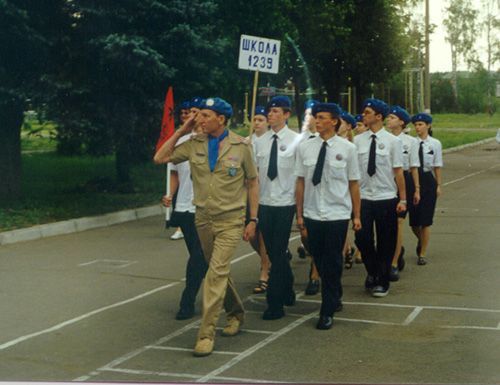
In the photo: Veteran peacemaker Eugene Komlyakov at the head of a squad of young peacemakers from secondary school No. 1239 of Moscow at a ceremonial march in Solnechnogorsk.
The 2-nd Game "Model of UN peacekeeping"
In 1999, the 4-day long educational and sports game "Model of UN peacekeeping -1999" took place in Solnechnogorsk, in which 250 schoolchildren from Moscow and the Moscow region took part.
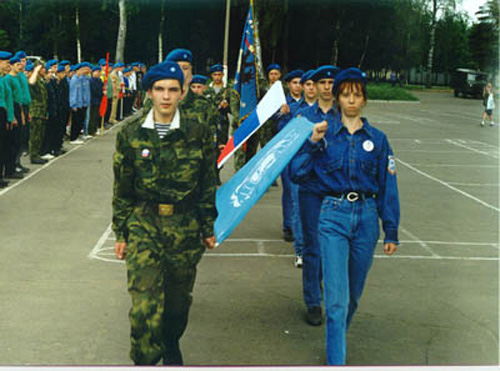
In the photo: The grand opening of the game on June 12, 1999. The guard of honor of the young peacemakers contributes flags of the UN and Russia.
Role of Museum of Peace in Peace education
Great importance for the dissemination of the ideas of peacemaking and the culture of peace has a museum exhibition. So far there are Peace Museums organized by young peacemakers and peacekeeping veterans in Moscow, Vladikavkaz, Kostomuksha, Zheleznovodsk, Minsk (Republic of Belarus) and Kharkiv (Ukraine)
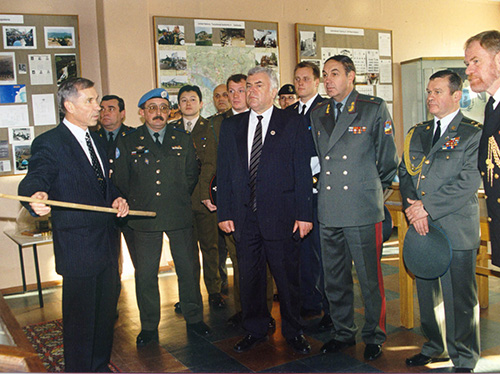
In the photo: Lecture for military attaches at the Museum of peacekeeping operations located on the courses "Vystrel" in Solnechnogorsk.
Symbols of Movement of Young Peacemakers and Schools of Peace
Symbols play an important role in the formation and development of the children's organization. The movement of young peacemakers unites children and adults who are interested in learning about the experience of UN peacekeeping. Considering the high prestige of the world community in maintaining universal peace, the Council of Veterans of the Museum uses the paraphernalia and symbols of UN peacekeepers to award for active peacemaking activities — the blue beret and the blue scarf. In addition, members of the Movement may be awarded with flags, diplomas, honorary badges (signs), certificates and letters of thanks from the Museum of Peacekeeping Operations, which can be issued both to organizations and individuals.
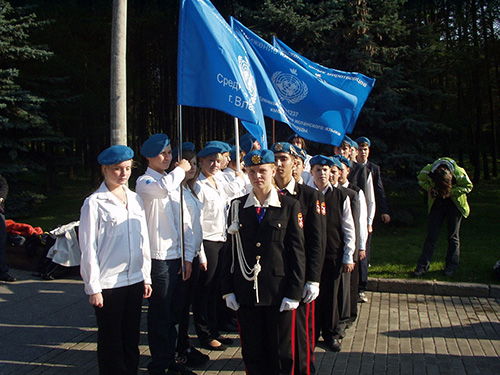
In the photo: Ceremonial presentation of the flag of the Movement of Young Peacemakers and Schools of Peace to Movement of Young Peacemakers of the Republic of North Ossetia-Alania.
COMPETITION OF YOUNG PEACEMAKERS "MISS PEACEMAKER - 2018"
The competition, held in Vladikavkaz in December 2018, was attended by representatives of schools of the Republic of North Ossetia-Alania, the regions of Russia and the Republic of Belarus.
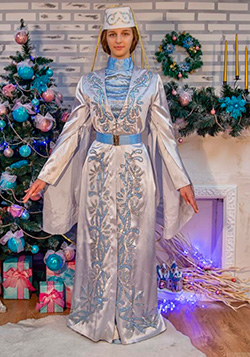
In the photo: Paziorina Daria, one of the winners of the contest. She is a member of the Council of the Young Peacemakers of the CIS countries in the Republic of North Ossetia-Alania.
Respect of National and International Traditions of Struggle against Fashism
In 2004-2010, the Movement of Young Peacemakers and Peace Schools took an active part in the Parades of Russian Youth, dedicated to the historical military parade of the Red Army on November 7, 1941 in Moscow.
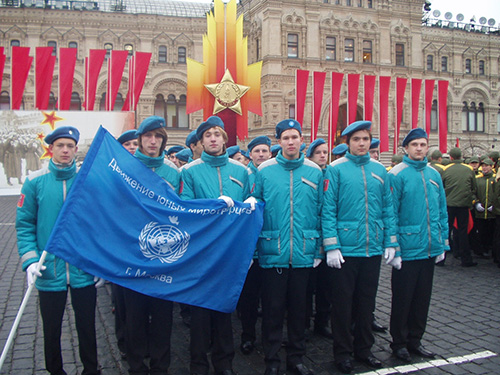
In the photo: Column of young peacemakers with its flag on Red Square in Moscow on November 7, 2009.
Placement of the Clubs
The location of the children's peace clubs and teams are secondary schools that have won the honorary right to be called peace schools within the framework of the Interdisciplinary program "Movement of Young Peacemakers and Schools of Peace"

In the photo: Club of young peacemakers of the center of education № 1804 in Moscow
International Cooperation
Internationalism as a characteristic feature of young peacemakers finds its realization in the organization of international cooperation between children's organizations and institutions of different countries.
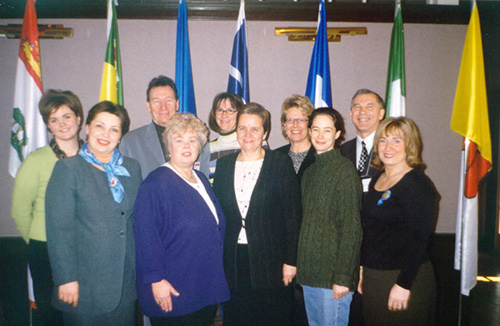
In the photo: Visit of Russian delegation to Pearson Peacekeeping Center in Canada
Peace Education Experience Exchange
The Movement of Young Peacemakers of Russia actively disseminates the ideas of peacemaking and culture of peace at the national and international levels through rallies, conferences, seminars, charity events, contests, sports and educational games.
All information about the work experience of veterans and young people in peace education is posted on the website of the Museum of Peacekeeping Operations, in the Voice of Peacemakers bulletin, as well as on Facebook, and on the websites of Peace Schools.
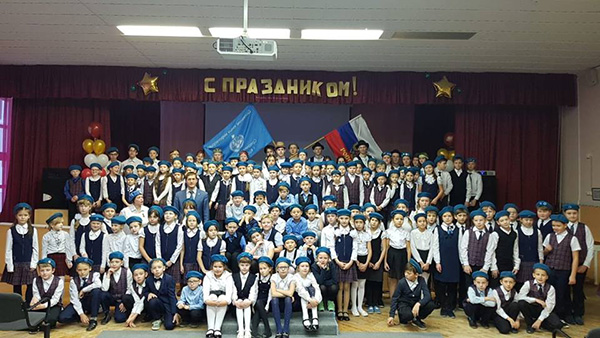
In the photo: The founders and participants of the project "Council of Young Peacemaker" on Facebook